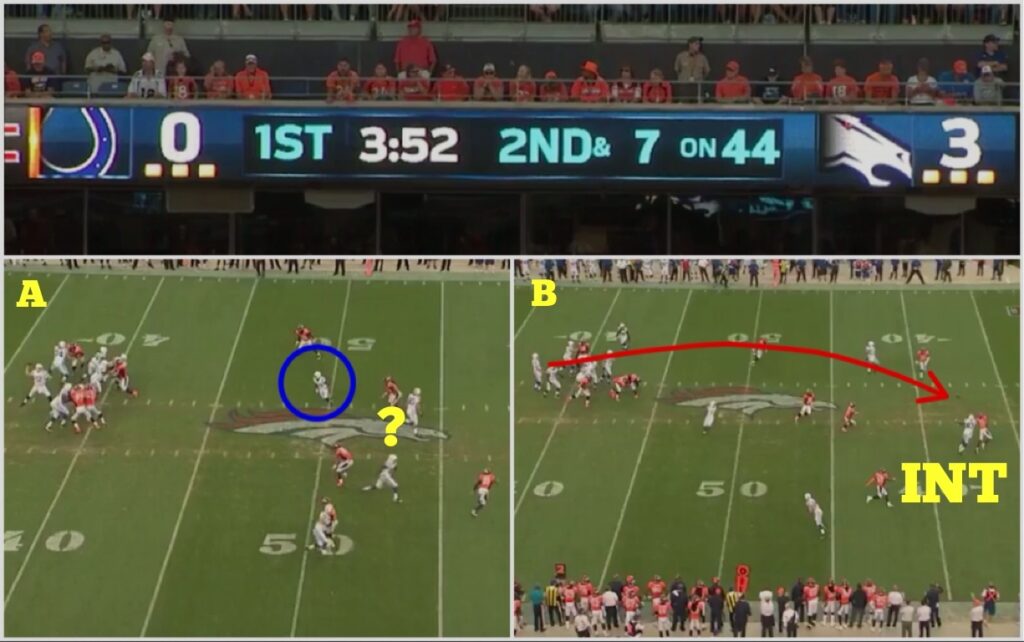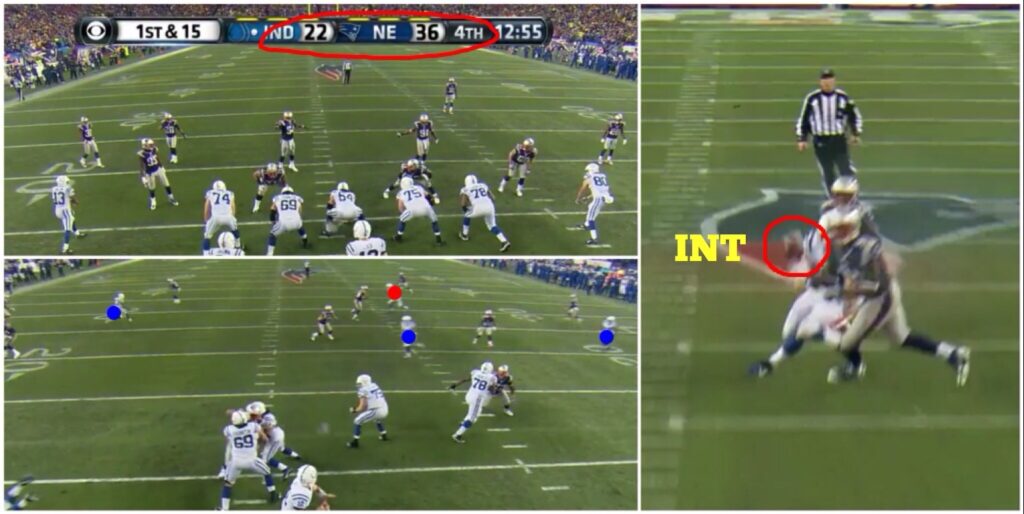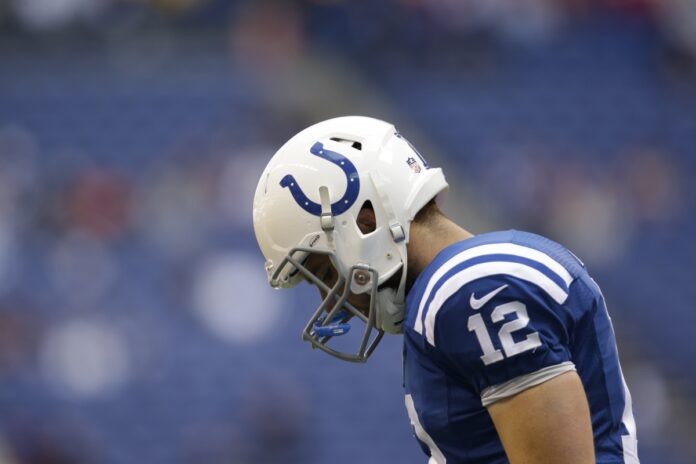When examining Indianapolis Colts quarterback Andrew Luck’s impressive stats for the 2014 season, including 26 touchdowns and over 3,000 passing yards, one can’t help but be amazed.
As the New England Patriots gear up to face the Colts in the highly anticipated Sunday Night Football AFC showdown, their focus should be on a particular aspect: Luck’s nine interceptions.
Interceptions can be game-changers, while touchdown passes often lead to victory.
Before delving into the discussion of Andrew Luck, it’s customary to express admiration for his skills and leadership qualities.
He is undeniably one of the most talented quarterbacks in the NFL and is seen as the league’s future, among other accolades.
However, from a defensive perspective, it’s crucial to recognize the vulnerabilities in Luck’s game that can be exploited on this November Sunday. In the immediate context, none of those above praises matter.
Unsurprisingly, Luck has thrown interceptions in his team’s losses this season. He has accumulated nine interceptions, with three games featuring multiple picks.
Of these games, two resulted in losses, and the other marked the Colts’ lowest offensive output of the season, with just 20 points scored against the Ravens.
In terms of defensive planning, this insight becomes pivotal. Coaches and players need to identify the situations that have led to Luck’s interceptions and, more importantly, devise strategies to put him in those vulnerable positions.
BEWARE THE ARM FAITH
When dealing with Andrew Luck, the primary objective should be inducing critical mistakes rather than merely applying pressure. Any football expert suggesting otherwise might be missing a crucial point.
It’s important to note that the majority of Luck’s interceptions this season, as well as in his lackluster playoff performance against the Patriots last year, were not due to pressure from the defense.
When teams attempt to pressure Luck, he displays an uncanny ability to evade additional rushers, often resulting in short completions or quick dumps to his targets.
Alternatively, he might skillfully slide and reset the pocket to exploit a secondary defense that’s now shorthanded.
What truly troubles Luck is his remarkable “arm faith,” which describes his unwavering confidence in his arm’s capacity to thread passes through windows that most human throwers would avoid.
He possesses an impressive highlight reel of incredible pinpoint throws, sometimes leading him to make unnecessarily risky attempts. Interestingly, he tends to rely on these “arm faith” throws more when he has time and space in his pocket to experiment.
While he may succeed in completing some of these daring throws, the ones that miss the mark have a disproportionately adverse impact on his team’s fortunes.
A notable instance of this can be observed in the first series of the AFC Divisional Playoff game last season against the Patriots.
In this scenario, the Colts spread their formation on a 3rd-and-2 play, prompting the Patriots to adopt a defensive strategy involving inside leverage with their defensive backs to nullify inside passes.
Alfonzo Dennard effectively disrupted wide receiver LaVon Brazill’s route and prevented the slant route from materializing.

In the context of the game, it’s essential to highlight Luck’s persistent determination to target a route that had already been effectively neutralized, and this was without facing any defensive pressure.
It was his initial read, leading him to attempt a powerful throw, but unfortunately for Luck, Dennard intercepted the pass and nearly returned it for a pick-six.
The critical defensive strategy that tends to induce the most mistakes from Luck is physical coverage designed to defend the field from the inside out. While Luck excels at threading the ball outside the numbers, these throws remain low-percentage passes.
Encouraging more throws of this nature should be a guiding principle for the Patriots’ defensive game plan.
THE TOM BRADY FACTOR
Navigating an offense to outscore Tom Brady undoubtedly exerts significant pressure on any mortal quarterback, even one as gifted as Andrew Luck.
This pressure became evident in the playoff game against the Patriots, where Luck found himself making uncharacteristic throws. The Patriots efficiently scored on nearly every possession, including three touchdowns in their first four trips to start the game.
Peyton Manning can also be placed in the same category, as Luck exhibited a similar tendency to force plays during a loss earlier this season against the Broncos.
Trailing by a modest 3-0 margin in the early stages of the game, Luck made a questionable decision, opting for a high-risk seam route to a receiver who was well-covered rather than a more straightforward sticks conversion (depicted by the blue circle below, left).
As expected, the result was an interception (depicted below, right), and it’s worth noting that there was no significant pressure on this throw either.

In the upcoming Patriots/Colts matchup, it will undoubtedly be intriguing to observe the choices that Andrew Luck makes early in the game and how these decisions align with the performance of the Patriots offense.
Has Luck learned to opt for the available options, or will he persist in attempting highlight-reel throws that might not be necessary if facing a less potent offense on the opposing sideline?
From the Patriots’ defensive standpoint, it’s essential to focus on not only defending inside-out but also maintaining top-down coverage.
There’s no need to employ a defensive strategy that encourages deep throws, as Luck is known to attempt such passes without any prodding. When he does opt for those deep shots, it becomes crucial for the defense to capitalize and make a play.
START FAST & DUMB LUCK WILL FOLLOW
This final point is somewhat intertwined with the previous discussion regarding Brady and Manning but introduces a notable shift in offensive philosophy for the Colts.
When Indianapolis finds themselves trailing on the scoreboard, regardless of the cause, they often veer away from their effective two-tight-end formations featuring Coby Fleener and Dwayne Allen.
Instead, they opt for personnel groupings with three wide receivers, essentially sidelining the traditional running game in favor of a spread and shotgun approach, often called “comeback personnel.”
From a defensive perspective, an impatient Colts offense presents an opportunity because even when trailing, they possess the firepower to gradually work their way back into the game using run plays and play-action passes designed for their running backs and tight ends.
When the Colts switch to a wide-receiver-focused game plan in a state of panic, it becomes a fortunate turn of events for the Patriots’ faithful.
This is a situation where Andrew Luck showcases both his best and worst attributes. He can sling the ball effectively, whether to his receivers or the opposing team’s.
The example below illustrates the game situation (highlighted in red) and the personnel grouping featuring three wide receivers (indicated by yellow dots) and a single tight end (represented by the red dot).
With Luck in the shotgun, this approach significantly limits the Colts’ running game playbook.
In the provided example, while trailing by 11 points early in the second quarter, Luck attempts one of his trademark sideline lasers. However, the defensive back anticipates the route, intercepts the pass, and returns it for a pick-six.

From a defensive perspective, the Patriots may not have direct control over their offense’s performance. Still, if their offense secures a lead, the secondary must remain vigilant against these throws.
In the example provided from last year’s divisional playoff game, even though it’s a later point, there’s still ample time for the Colts to stage a comeback.
As Andrew Luck surveys the field, he has both time and open receivers (as indicated by the blue dots in the image below, left).
However, he opts for the high-risk “hell-no!” option (highlighted in red), which unsurprisingly results in an interception by the lurking Jamie Collins.
Maintaining this level of awareness for such throws is imperative for the Patriots’ secondary when they have a lead, as it can be a game-changing factor.

Andrew Luck’s occasional lapses in judgment tend to surface primarily when his team is trailing. This facet of the game is an area that the Patriots can influence by taking advantage of early offensive opportunities.
Failing to do so may result in Luck not displaying any such lapses, especially if he manages to lead his team to an early lead.
It wouldn’t be unexpected if much of the game’s outcome is determined by the early action. While Andrew Luck is undoubtedly a formidable force on the field, there’s a specific approach to playing him that can increase the chances of success.
It involves focusing on when the opportune moments for capitalizing on his potential missteps will likely arise.
The Patriots/Colts matchup promises to be an entertaining football game and one of the highlights on the NFL schedule this week.
That being said, the Patriots’ blueprint for securing a victory against a team led by Luck should be no surprise to anyone.

